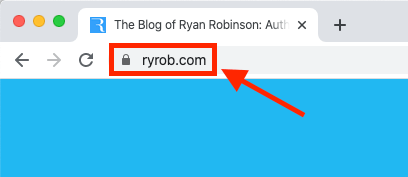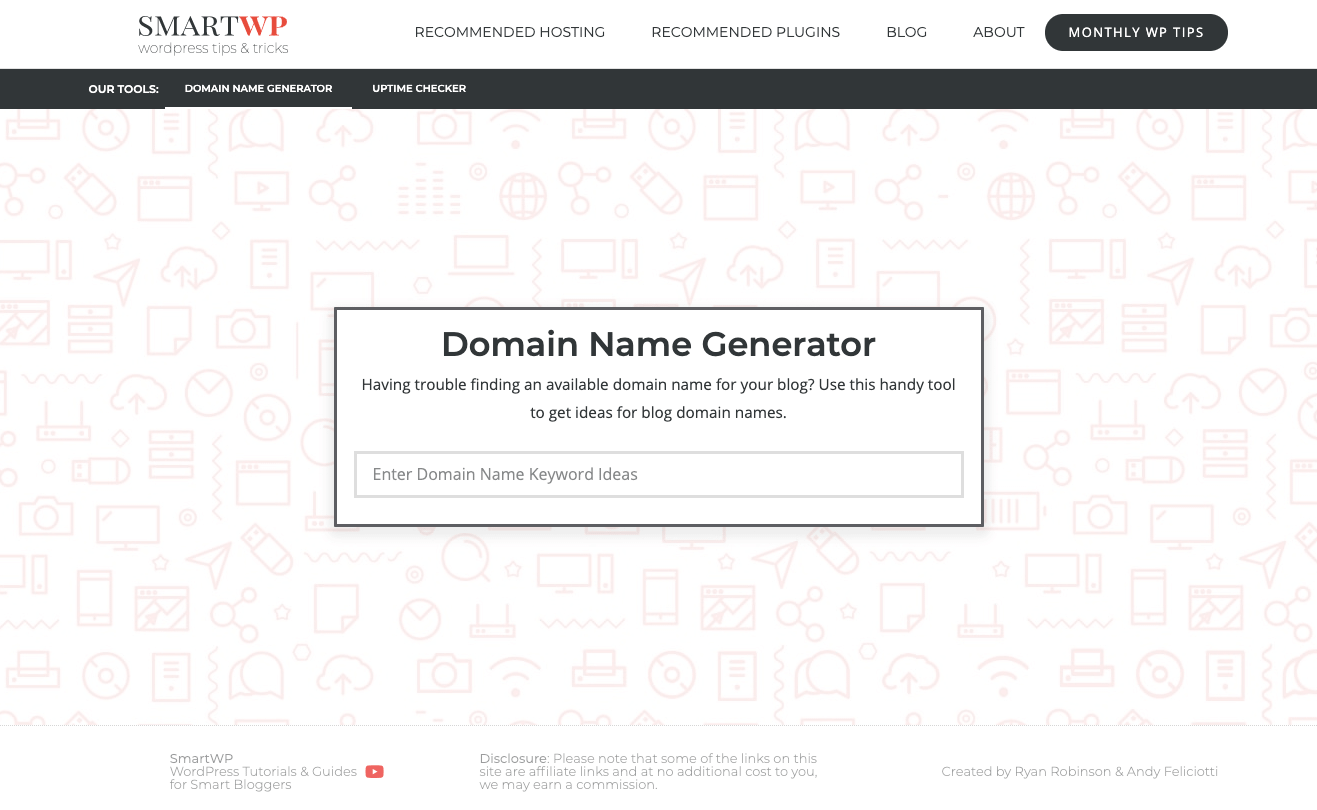In this guide, I’ll walk you through the steps for learning how to choose a domain name that’s not only available but is easy to read, understand, and forges a lasting memory in the minds of your readers. But first…
What is a domain name?
Your domain name is your address on the Internet. It’s the URL (web address) that people will type in, to navigate straight to your blog. You’ll often hear domain names referred to as an “address,” “web address” or “blog URL” interchangeably, but they’re all one in the same. Your domain name appears in the “address bar” at the top of your browser window, like so:
For example, the domain name for my blog here is ryrob.com (as you can see in the screenshot above and in your own address bar right now).
A domain name is made up of two distinct parts:
- The blog’s name itself (which can be anything you want—so long as it’s available and no longer than 63 characters)
- The suffix (this is the .com, .net, .org, .biz, .info, etc. at the end of your domain name)
The domain name you choose matters a lot.
It becomes part of the brand for your blog. It’s the name readers will remember… and even your domain name alone can attract (or turn away) readers.
This is why so many bloggers get stuck on how to choose a domain name during the process of learning to start a blog. It’s easy to fall into the temptation of wanting the perfect domain name—when it feels like all the best domain names are already taken. Or maybe you just don’t know where to begin, because all the names you’re coming up with seem a bit bland or uninspired.
Check if your domain name is available:
Here’s what you can do, to make sure you choose a domain name that’ll help your blogging efforts in the long run.
How to Choose a Domain Name for Your Blog in 10 Easy Steps
- Choose the Right Niche
- Figure Out Your Topic (and Angle)
- Decide on Your Target Audience
- Brainstorm Words Related to Your Blog
- List Out 10 Example Blogs You Enjoy
- Write Down as Many Potential Domain Names as You Can
- Pick Your Top 10 Domain Names
- Try a Domain Name Generator
- Consider the 7 Key Factors That Make a Smart Domain Name
- Register Your Domain Name
- Bonus: 21 Domain Name Examples to Inspire Your Search
Disclosure: Please note that some of the links below are affiliate links, and at no additional cost to you, I’ll earn a commission. When you purchase a product or service using one of my affiliate links, the company compensates me, which helps me run this blog and keep things like my 25,000-word ultimate guide to starting a blog free of charge. Know that I also only recommend products and services I personally stand behind.
Ready to Start Your Blog Today?
Check out my ultimate guide How to Start a Blog (on the Side) that’s been featured on Forbes, Inc and Entrepreneur.
1. Choose the Right Niche
Before going further in your quest to learn how to choose a domain name that’s right for you—you’ll need to be sure that you’re in the right blog niche, first and foremost.
What is a blog niche?
A blog niche is a carefully selected topic area that you’ll be focusing your blog content around. In simpler terms, picking a niche is really just another way of determining the overarching topics and themes you’ll be writing about on your blog.
This doesn’t necessarily mean picking the same niche all your friends write about—or the niche that seems to be the latest hot trend online. This decision may not even mean pursuing a niche that’s traditionally easy to monetize.
Choosing the right niche (and eventually a smart domain name) should be a decision fueled by the combination of two major factors:
- You can write at-length: Your niche needs to be composed of content topics you can plausibly write about for the months and years to come (and continue enjoying it—you’ll also want to invest in learning how to write a headline that’ll capture the attention of your target readers).
- You can eventually monetize: Your niche should also have a proven path to eventually making money from your blog.
The best blog niche for you will live at the intersection of topics you love—and proven monetization potential.
For a whole lot more on this subject, read my extensive guide: How to Pick a Niche to Blog About (+ Profitable Blog Niche Examples).
2. Figure Out Your Topic (and Angle)
Once you’ve picked a niche for your blog, you’ll need to narrow it down further.
- Is there a particular approach you could take within the niche that’d make your blog stand out?
- Do you have any unique experience, skills, or interests that can help you find a clever angle?
This might mean bringing together two related but distinct topics (which could even form the basis of a domain name—like Copyblogger’s combination of “copywriting” and “blogging”).
It might mean tackling a well-worn topic with an underserved audience in mind, like IttyBiz’s marketing advice for tiny (often one-person) business owners.
You could also approach this equation by thinking about your own style or voice when you sit down to write a blog post. For example:
- You might want to bring humor to a topic that’s traditionally been more buttoned up.
- Or maybe you’ll take a no-nonsense, hard-hitting way of writing within a niche that needs a serious voice.
Your tone can then be reflected in how you choose a domain name, like the wordplay in “Making Sense of Cents” (a blog by my friend, Michelle Schroeder), which suggests that her personal finance blog won’t be just another dull and serious advice column. Check out more of my picks for the best blog examples to see how others choose clever domain names in different niches too.
The important thing to remember is that no matter which niche you choose to blog in—there will already be dozens of popular blogs out there.
Finding a specific topic to focus on with a fresh angle can help distinguish your blog from others.
3. Decide on Your Target Audience
Ideally, you want to decide on the who your blog will reach and start learning how to find your target audience well before you pick a domain name—because who your readers are can make a big difference on your branding decisions ranging from the name of your blog, to the colors, logo design features and more.
In making decisions about the audience you’ll be creating content for, seek to answer questions like:
- Who are a few specific people you’ll be blogging for?
- Which demographics and psychographics describe the people in your ideal audience?
- What are the kinds of problems you hope to solve for your readers?
For instance, if you’re starting a blog about money-saving tips aimed at stay-at-home moms with young kids, it will look quite different from a blog about money-saving tips for young male startup founders and entrepreneurs. You’ll naturally want to choose a domain name that resonates most with your audience of stay-at-home moms.
You’ll want to think about your audience not only in terms of demographics (their age, gender, physical location), but also their psychographics (values, interests, attitudes and belief systems). Are there any words you’ll want to use—or avoid—to ensure you’re sending the right signals to your target audience?
For more on this subject, read through my guide: How to Name a Blog (the Smart Way) + 25 Genius Blog Names
4. Brainstorm Words Related to Your Blog
Now that you’re clear about your blog’s niche, angle, and who your target audience is going to be, it’s time to start brainstorming words to help choose a domain name.
It’s time to grab a sheet of paper, open a new Google Doc, or open your favorite mind-mapping application.
Jot down as many words and phrases as you can think of that relate to your vision for your blog. These words might have something to do with:
- Your niche (i.e., “gardening” or “entrepreneurship”)
- Your audience (i.e., “busy parents” or “job seekers”)
- Your style or personal brand (i.e., “kind,” or “irreverent,” or “magical”)
These words themselves may not become what you choose as a domain name for your blog—though you might come up with some ideas you’ll want to incorporate.
Spending some real time on this and thinking through some fun word combinations should help you to narrow down at least a few potential domain name ideas.
5. List Out 10 Example Blogs You Enjoy
Pick your favorite 10 or so blogs (ideally within your niche) and write down their domain names.
If you don’t read many blogs yet, find a list of blogs in your general topic area—and see which domain names jump out as being particularly interesting.
- What can you learn from these sites?
- Are there any common words that could spark some inspiration for a word you may want to incorporate into your own domain name?
- Do these examples help you feel a strong conviction about ways you’ll want to position your own domain name?
Maybe there’s a mix of different types of domain names in your example pool.
You could have some blogs that are personal brands (named after the blogger) and others that domain names clearly designed to preview the topics at-hand.
Perhaps the domain names you’re seeing are fairly short and easy to remember.
Maybe some were tricky to spell, forcing you to look them up first before simply navigating there.
Either way, you should be able to walk away from this activity with a lesson or two about what you do and don’t like in a domain name within your niche.
6. Write Down as Many Potential Domain Names as You Can
Now finally, the fun part of learning how to choose a domain name—putting the pen to (metaphorical) paper!
At this point, you’re ready to start coming up with your own domain name ideas.
My advice is to set aside some time for this—ideally an hour or two when you can focus on this process, uninterrupted. This could be a great excuse to head to your favorite coffee shop.
It’s important to list as many ideas as you can for domain names, as there’s a good chance many of your ideas will already be taken. Remember, too, that a not-quite-perfect idea can often help you move forward to something better over the course of this exercise (or even days later).
Below, at #9 in this guide, is my more detailed process that walks through the seven key factors in choosing a domain name—so take a look at this to help you come up with more ideas.
7. Pick Your Top 10 Domain Names
Once you’ve created your list, choose your top 10 potential domain names and check which ones are available.
A great place to check your domain name availability is Hover. Here, you can type in a domain name and search to see whether it’s already registered.
If it is registered by somebody else already, my advice for now is to move on to the next potential domain name on your list. While it’s possible to get a domain name that’s currently taken by someone else (by purchasing it either directly from the seller or through a brokerage firm), that’s likely to cost well into the hundreds or even thousands of dollars—depending upon the domain.
Normally, you’ll want to register a domain name with the suffix .com (see the 7 key factors below for more on this).
Sometimes though, it might make sense to pick a local suffix (like co.uk or .in) or a less common extension like .net or .co if your ideal .com isn’t available.
As I mentioned above, if you find that a domain name you love is taken, it’s possible the person who owns it might be willing to sell.
This could cost anything from a hundred dollars to many thousands, depending on how valuable the domain name is perceived to be (and whether or not they’ve just registered the domain or built a site there, too).
My advice at this stage is to register an available domain name to start your blog. Once you have a budget for domain acquisitions, you can always upgrade to buying that perfect domain later on down the line.
8. Try a Domain Name Generator
If you’re struggling to find an available domain that you like, or if you haven’t managed to come up with many ideas, a domain name generator could help.
My friend Andy and I actually built one over here on SmartWP, to help with the challenge of coming up with great (available) domain names:
There are many different domain name generators available, but they all work in essentially the same way. They let you input a keyword or phrase (which will normally be related to your niche), and they generate a list of potential domain names you could use.
Most domain name generators will indicate whether or not those domains are actually available, too—and many offer up easy links so you can buy the domain name you like right away.
For more, check out my list: 21 Best Domain Name Generators for Bloggers.
9. Consider the 7 Key Factors That Make a Smart Domain Name
If you have several potential domain names to choose from and don’t feel strongly attracted to any particular option, run each of your domain names through this test.
You might not be able to nail all of these factors perfectly when choosing a domain name for your blog, but the more you can check off, the better your domain name will likely be in the long run.
1. A Good Domain Name is Reasonably Short
Yes, domain names can have up to 63 characters (not counting the suffix), but you definitely don’t want to use them all. Pretty much never.
If your domain name contains more than three words, consider whether you could go with something shorter. Domain names that are too long are often perceived as spammy.
Short domain names are also easier to show in a video, on social media, and printed on business cards, and most importantly, they’re more memorable to readers.
2. Smart Domain Names Leave No Ambiguity
Because a domain name displays as all lower-case letters in a browser address bar—and because people tend to type them that way when sharing a blog’s name with others—you must look out for accidental ambiguities or potentially embarrassing misspellings.
For example, here are a few unfortunately named sites (that didn’t do a great job when choosing a domain name):
- penisland.net
- expertsexchange.com
- childrenslaughter.com
While the names of these sites are actually “Pen Island,” “Experts Exchange,” and “Children’s Laughter…” that may not have been immediately clear when just scanning the domain name.
The impression your readers form at first glance is very important, so be sure not to leave any room for misinterpretation when learning how to choose a domain name for your blog.
For more great examples, check out this hilarious list on Bored Panda.
3. Make Your Domain Name Easy to Spell
Avoid using unusual or commonly misspelled words in your domain name.
If you’re considering using your own name, you might want to think twice if it has a particularly unusual spelling. To be fair, using my nickname for this blog hasn’t led to any particular challenges.
Avoiding hyphens (-) and numerals (1, 2, 3) in domain names is also a good idea.
These are sometimes associated with low-quality or spammy websites, making it tricky for people to remember exactly how to type your domain name into their address bar.
4. Be Sure it’s Easy to Read Aloud
Domain names that pass the above three tests will normally be easy to read aloud… but it’s worth saying your domain name out loud just to be sure.
Eventually, you’ll want to be able to say your domain name in conversations, on podcasts, and perhaps even in radio interviews, so make sure it’s easy to understand without having to laboriously spell the whole thing out.
5. Try to Ensure it Indicates Your Topic
Ideally, your domain name should hint at your blog’s topic.
This isn’t necessarily a deal-breaker, though.
Plenty of successful blogs have gained popularity with names that don’t really have much to do with what they offer.
Once upon a time, nobody associated the word “Amazon” with books or online shopping.
6. Choose a Domain Name that Gives a Sense of Your Brand and Style
If you have a particularly strong brand or writing style, then it’s worth trying to incorporate this into your domain.
For instance, you might want to include a sense of fun or humor in your site’s name or use a word that reflects your personality.
7. Always Try for a .com Domain Extension
While hundreds of potential domain name extensions exist, none have caught on as much as “.com.”
Originally designed for use by commercial websites in the US, it’s become the worldwide preference for all sorts of websites—and it’s the suffix that people will tend to type in if they’ve forgotten your site’s domain name.
In some cases, it might make sense to use a local domain if you’re selling to a predominantly local audience. Normally, though, .com is your best option.
If you can’t get a .com for the name you want, though, a good second choice is a .co, .net, or .org, which have all become great (common) alternatives today.
This should help you narrow down your domain names to choose the best option.
For example, a shorter name is generally better than a longer one—all else being equal, and a name that’s easy to spell is better than one that’s confusing or ambiguous.
10. Register Your Domain Name
Finally… it’s time to register your chosen domain name.
Luckily, there are now plenty of places you can register your domain name for just a few bucks. If you’ve already chosen a web hosting plan, it’s generally easier to register your domain name with the same company that hosts your other assets—and some will even throw in a free domain name when you sign up for hosting.
My recommendation for where to quickly register your domain name (for a great deal) is with Hover:
Some alternative options include domain registrars like GoDaddy and Namecheap, but consider reading these honest Bluehost reviews, too.
21 Clever Domain Name Examples (and Approaches to Choosing a Domain Name)
If you’re still unsure how to choose a domain name for your blog, look at these popular examples and approaches.
1. Use Part (or All) of Your Own Name
Using your own name, or part of it, for your domain name is simple. It makes branding yourself a bit trickier (unless you’re already well-known), as your name doesn’t have an inherent link to your topic. It also doesn’t work well if you have a very common name already registered online.
Examples of domain names using this approach:
- ryrob.com (Ryan Robinson 👋)
- michaelhyatt.com (Michael Hyatt)
- stevepavlina.com (Steve Pavlina)
2. Describe What Your Readers Will Accomplish
If you’re clear about what your blog will do for readers, you could choose a domain name that describes that mission. This approach has the advantage of making your domain name act like a tagline or mini elevator pitch for your site—readers will be clear what your site can help them achieve before they even visit it.
It tends to lead to quite long domain names in many cases.
Examples of domain names using this approach:
- makealivingwriting.com (Make a Living Writing)
- liveboldandbloom.com (Live Bold and Bloom)
- convinceandconvert.com (Convince & Convert)
3. Describe What You Plan to Do for Your Readers
This is a similar approach to #2, but the domain name focuses on what you do rather than what readers will do.
Again, it can be a great way to convince readers to check out your blog based solely on your domain name alone, though there’s the danger it could seem a little egotistical.
Examples of domain names using this approach:
- iwillteachyoutoberich.com (I Will Teach You To Be Rich)
- helpingwritersbecomeauthors.com (Helping Writers Become Authors)
- careerigniter.com (Career Igniter)
4. Come Up With a Clever Play on Words
If your brand is light-hearted, fun, irreverent or humorous, then work to learn how to choose a domain name that’ll involve a fun play on words. It can be a great way to get attention and to brand your site over the long haul.
Examples of domain names using this approach:
- Making Sense of Cents (.com) (Michelle Schroeder’s Making Sense of Cents finance blog)
- additude.com (ADDitude – a blog about helping loved ones with ADD/ADHD)
5. Put Together Two Words to Create a Brand
Sometimes, mashing together two words can help you come up with a great new brand within your domain name. This has the advantage of generally leading to short domain names—though if you don’t put enough thought into it, you might end up with an odd or confusing domain name that people struggle to spell, read or speak.
Examples of domain names using this approach:
- vegananj.com (VeganAnj)
- copyblogger.com (Copyblogger)
- kissmetricshq.com (Kissmetrics)
- techwalls.com (TechWalls)
6. Create a New Word by Adding a Prefix or Suffix
Another approach to creating your own unique brand is to pick a core word about your topic and then add a prefix or suffix to that word. Some you might like to try out include:
- Prefixes: pro, un, co, hyper, macro, micro
- Suffixes: ly, ful, ic, ness, less, ist, ize, ify
Examples of domain names using this approach:
- problogger.com (ProBlogger)
- unmarketing.com (UnMarketing)
- shopify.com (Shopify)
7. Use Keywords
Is there a particular keyword phrase that’s integral to your blog?
Use My Free Keyword Research Tool
Try my free AI-Powered Keyword Tool to get dozens of research-backed ideas for keywords & topics to write about on your blog today.
While having your keywords in your domain name is no longer a major ranking factor, it can still be a helpful way to brand your site—and it definitely won’t hurt from a blog SEO perspective, either.
Examples of domain names using this approach:
- trafficgenerationcafe.com (Traffic Generation Cafe – keyword phrase is “traffic generation”)
- css-tricks.com (CSS-Tricks – the whole domain is the keyword phrase)
- searchenginewatch.com (Search Engine Watch – keyword phrase is “search engine”)
If you’re still stuck on learning how to choose a domain name at this point…
My advice is to try using one of these domain name generators to suggest a few ideas for available domains that you can register and hit the ground running with today.
What if the Domain Name You Want is Already Taken?
Listen, it’s 2025. The chances are pretty high that your first-choice domain name is already taken. If it’s not, then I recommend registering it immediately!
But given the fact that there are now nearly 32 Million bloggers in the U.S. alone, you’re probably going to need a few backup domain name ideas or a game plan to go with should your top choices be unavailable. Here’s what to do if your ideal domain name is already taken:
Option #1: Brainstorm New Possibilities
The easiest (and lowest-cost) option is to go back to the drawing board and choose a domain name that hasn’t already been taken. Sure, it’s a bummer that your first-choice domain names are already gone, but that’s the reality of the world we live in.
If your creative energy is running low and you’re disappointed by striking out on a few domain names, give yourself a little break from working on finding the right name for now.
Once you’re feeling refreshed, come back and consult one of the top domain name generators, like the SmartWP Name Generator, to see if any of the suggestions they offer spark some great new domain name ideas for you to go with.
Option #2: Choose a Different Domain Extension
ProBlogger did this originally when they just got started with their blog. They began as “ProBlogger.net” and eventually bought the .com extension later on down the line after they’d built a meaningful business around their blog.
The company I used to work for, Close.io also recently purchased the Close.com domain name—after it made financial sense for them to invest in the premium priced URL (and they knew their business wasn’t going anywhere).
Option #3: Ask to Buy the Domain Name
Coming up with a great domain name can be tricky, especially if you’re in a big, popular niche where it seems like all of the best domain names have been taken.
Don’t waste a ton of time trying to find the perfect domain name, though.
Plenty of incredibly popular blogs have succeeded with some extremely odd domain names. Take these for example:
- Blind Five Year Old
- Mr. Money Mustache
- Crazy Egg
Other blogs have taken the approach of rebranding once their original name no longer seemed like the right fit—Smart Blogger, for instance, used to be called Boost Blog Traffic before Jon felt the need to broaden his appeal.
Take some time to brainstorm the right domain name ideas, consider asking friends for feedback if you’re struggling to figure out how to choose a domain name that feels right for your blogging goals—and try out a domain name generator if you’re still stuck.
Need Catchy Blog Title Ideas?
Try my free AI-Powered Blog Title Generator Tool to get dozens of SEO-friendly headline ideas to make your blog posts stand out today.
But above all else, commit to choosing a domain name within a reasonable period.
I recommend marking a final decision date on your calendar to register a domain name… and then move on to the next steps of really starting your blog and beginning to attract an audience.
Ready to Start Your Blog Today?
Check out my ultimate guide How to Start a Blog (on the Side) that’s been featured on Forbes, Inc and Entrepreneur.










Thanks for this really necessary information. The point you mentioned regarding that the domain name should be related to your topic as this will really help to understand the audience from domain for what this website is about.
You’re welcome, Joel! Glad you found some value in this tutorial 🙂
This article is so helpful and informative, thank you.
Glad to hear that, Saiful! You’re welcome 🙂
Great article with helpful content. The above-mentioned tips are very useful for me.
Glad to hear that, Jerry! Good luck with your blog 🙂
Thanks for share, this has really good content value
You got it! 🙂
You recommended that the domain name be easily read—and does not give easy opportunities to make spelling or pronunciation mistakes. I agree, a name on the Internet should be easy to type in the browser when someone says it verbally. If there is room for mistakes, they are missed readers.
Ideally, yes! I’ve seen plenty of domain names work well for a blog while still being a little difficult to spell, but I’d say that’s the exception to the rule, for sure.
Hey Ryan,
Helpful Article. I just started blogging and have written more than 20 blog posts but I have not focused much on the domain name. Thanks for explaining these beneficial points.
Nice! It sounds like you’re focusing on what matters most right now—keep up the great work 🙌
This post is so helpful and straight to the point.
I just started blogging this month. Choosing a domain name was a big hustle. After reading this post few days ago, it was easy for me to choose one.
The points under this heading “Consider the 7 Key Factors That Make a Smart Domain Name” are greatly helpful.
Thanks Ryan Robinson.
Thanks so much, Jerry! Glad you’re off to a good start, yourself 🙂
Thanks Ryan, This has been very helpful! Its going to be my very first time to blog:)
You’re welcome, Anna! Wishing you luck 🙂 be sure to read through my (free) guide on how to start a blog here: https://www.ryrob.com/how-start-blog/